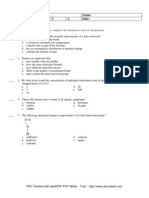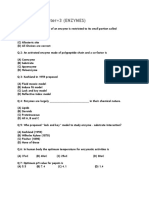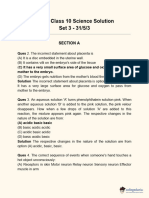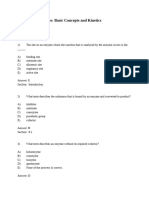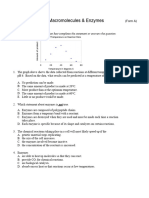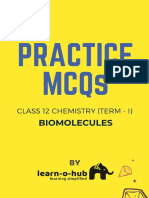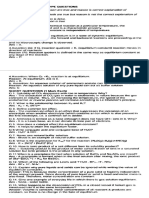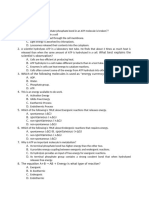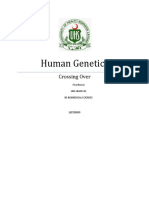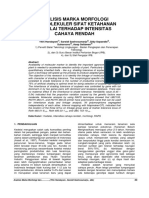5-Mcq-1enzymes-24 DPH
5-Mcq-1enzymes-24 DPH
Uploaded by
pharmamylife2Copyright:
Available Formats
5-Mcq-1enzymes-24 DPH
5-Mcq-1enzymes-24 DPH
Uploaded by
pharmamylife2Original Title
Copyright
Available Formats
Share this document
Did you find this document useful?
Is this content inappropriate?
Copyright:
Available Formats
5-Mcq-1enzymes-24 DPH
5-Mcq-1enzymes-24 DPH
Uploaded by
pharmamylife2Copyright:
Available Formats
Q:1: The catalytic activity of an enzyme is restricted to its small portion called
(B) Passive site
(C) Allosteric site
(D] All Choices are correct
Q:2: An activated enzyme made of polypeptide chain and a co-factor is
{A) Coenzyme
|B) Substrate
(C) Apoenzyme
Q:3: Koshland in 1959 proposed
A} Fluid mosaic model
{€) Lock and key model
D] Reflective index model
Q:4: Enzymes are largely in their chemical nature.
(4) Lipids
(B] Steroids
(D) All &, B and C
Dr. Ehab Aboueladab, Associate Prof.Dr. Of Biochemistry and Nutrition,
email:ehabl0f@gmail.com
Q:5: Who proposed “lock and key" model to study enzyme — substrate interaction?
{A) Koshland {1959)
(B) Wilhelm Kuhne (1878)
(D) None of these
@:6: In human body the optimum temperature for enzymatic activities is
(B) 400C
(€) 250C
(D) 30aC
Q:7: Optimum pH value for pepsin is
(455
(8)7.4
(a1
Q:8: Competitive inhibitors stop an enzyme from working by
{A) Changing the shape of the enzyme
B} merging with the substrate instead
D) combining with the product of the reaction
Dr. Ehab Aboueladab, Associate Prof.Dr. Of Biochemistry and Nutrition,
email:ehabl0f@gmail.com
Q:9: The enzymes are sensitive to
{A) Changes in pH
|B) Changes in temperature
(D) None of these
Q:10: Enzyme B requires Zn2+ in order to catalyze the conversion of substrate X. The zinc is
best identified as a|n):
{A) Cosnzyme
(C) Substrate
(D) Product
Q:11: The enzyme minus its coenzyme is referred to as the
(A) Iso-enzyme
(B) Metalloenzyme
(D) Al of these
Q:12: The “lock and key” model of enzyme action illustrates that a particular enzyme
molecule
{A) forms a permanent enzyme-substrate complex
(B) may be destroyed and resynthesized several times
(D) reacts at identical rates under all conditions
Dr. Ehab Aboueladab, Associate Prof.Dr. Of Biochemistry and Nutrition,
email:ehabl0f@gmail.com
Q:13: Consider this reaction. A+ B -> C + D + energy.
{A) This reaction is exergonic
(B) An enzyme could still speed the reaction
{€) A and B are reactants; C and D are products
Q:14: An inhibitor that changes the averall shape and chemistry of an enzyme is known as
ajn)
{A) Aute-steric inhibitor
(B) Competitive inhibitar
(C) Steric inhibitor
@:15: Non-protein components of enzymes are known as
(A) Coenzymes
(B) Activators
|€) Cofactors
Q:16: The reaction below occurs within the cells to prevent the accumulation of hydrogen
peroxide. In this reaction, catalase functions as an
{B) Enzyme in the synthesis of hydrogen peroxide
(C) Emulsifier in the digestion of hydrogen peroxide
(D) Indicater in the detection of hydrogen peroxide
sH0, Snlae oy 0.0,
Dr. Ehab Aboueladab, Associate Prof.Dr. Of Biochemistry and Nutrition,
email:ehabl0f@gmail.com
Q: 17: An enzyme is generally named by adding to the end of the name of the
(A} "-ase”. coenzyme
(B) "-ase". cell in which it is found
{C) "-ose". substrate .
Q:18: The minimum amount of energy needed for a process to occur is called the
{A) Minimal energy theary
|B} Process energy
{C) Kinetic energy
Q:19: A student conducts an experiment to test the efficiency of a certain enzyme. Which
would probably not result in a change in the enzyme's efficiency?
{A) Adding an acidic solution to the setup
|B) Adding more substrate but not enzyme
{C) Increasing temperature of solution
Q:20: Enzymes function as
(B) Inorganic catalysts
(C) Inhibitors
(D) all of these
Dr. Ehab Aboueladab, Associate Prof.Dr. Of Biochemistry and Nutrition,
email:ehabl0f@gmail.com
Q:21: A catalyst is a chemical involved in, but not by, a chemical reaction.
(A) Supported
(C) Controlled
(D) All of these
@:22: Many enzymes function by the activation energy of reactions.
{A) Increasing
(B} Promoting
(D) Both A and B
Q:23: An uncatalysed reaction requires a
{B) Lower activation energy
(C) Balanced activation energy
(D) All of these
Q:24: It suggests that the binding of the substrate to the enzyme alters the structure of the
enzyme, placing some strain on the substrate and further facilitating the reaction.
{A) Lock and Key hypothesis
{B) Induced fit hypothesis
(C) Fischer’s hypathesis
Dr. Ehab Aboueladab, Associate Prof.Dr. Of Biochemistry and Nutrition,
email:ehabl0f@gmail.com
You might also like
- Unit 3 MCQDocument13 pagesUnit 3 MCQMajd Haddad100% (1)
- Aqa A Level Biology Importance of MembranesDocument3 pagesAqa A Level Biology Importance of Membranesgayatribala306No ratings yet
- Unit Test 1 Grade 12 BioDocument8 pagesUnit Test 1 Grade 12 BioSarah KwanNo ratings yet
- Biochemistry MCQDocument11 pagesBiochemistry MCQSurajit Bhattacharjee100% (1)
- Enzymes: Biology-Xi Chapter No-03 Encircle The Correct OptionDocument3 pagesEnzymes: Biology-Xi Chapter No-03 Encircle The Correct OptionParkash Kumar Rathore100% (2)
- AP Bio Multiple Choice TestDocument6 pagesAP Bio Multiple Choice Testabkaminska100% (4)
- BIS 2A Midterm 1 UC DavisDocument10 pagesBIS 2A Midterm 1 UC Daviscrahimi26No ratings yet
- O Level Biology Practice Questions And Answers EnzymesFrom EverandO Level Biology Practice Questions And Answers EnzymesRating: 5 out of 5 stars5/5 (1)
- Recombinant DNA: Module in General Biology 2Document27 pagesRecombinant DNA: Module in General Biology 2Shastine Claor100% (2)
- Old Photo Respiration Test With Answer KeyDocument11 pagesOld Photo Respiration Test With Answer KeySamuel SiyumNo ratings yet
- MCQ TEST Chapter 3 (ENZYMES)Document14 pagesMCQ TEST Chapter 3 (ENZYMES)Ali HyderNo ratings yet
- Quiz On Enzyme KineticsDocument16 pagesQuiz On Enzyme Kineticschifunndo charlesNo ratings yet
- 3rd Chapter Biology (Practice Test NUST)Document11 pages3rd Chapter Biology (Practice Test NUST)Muhammad Sohail 845-FSL/LLB5Y/S22No ratings yet
- 5 MCQ 1-EnzymesDocument1 page5 MCQ 1-EnzymesMahira Muhammad HaroonNo ratings yet
- Second examDocument38 pagesSecond examaa10102016No ratings yet
- CH 8 QDocument31 pagesCH 8 QdenisseumalibautistaNo ratings yet
- Test BankDocument28 pagesTest BankMa Anna Cris Lumongsud50% (2)
- CBSE_Class_10_Science_Set_3_31_5_3__5d143ab10d03f0fa7bd30933e195ed3eDocument15 pagesCBSE_Class_10_Science_Set_3_31_5_3__5d143ab10d03f0fa7bd30933e195ed3edipensheth111No ratings yet
- Enzymes BC MCQDocument10 pagesEnzymes BC MCQranganathansuganthanNo ratings yet
- bio301 ch 8,9,10,11,12,13,14Document80 pagesbio301 ch 8,9,10,11,12,13,14godspeedNo ratings yet
- CH 08Document10 pagesCH 08John Jeric San JoseNo ratings yet
- Biochemistry MCQ PDFDocument11 pagesBiochemistry MCQ PDFjfjfjfNo ratings yet
- MCQ On PeptidesDocument40 pagesMCQ On Peptidessima simaNo ratings yet
- Questions - Enzymes - Answer KeyDocument7 pagesQuestions - Enzymes - Answer KeyBUG50% (2)
- Sci Quiz Bee 24Document7 pagesSci Quiz Bee 24Stef RabadonNo ratings yet
- QZBCH Biochemistry Questions 1.2Document7 pagesQZBCH Biochemistry Questions 1.2bruicetalentamperezaNo ratings yet
- Chemistry of Life Practice QuestionsDocument8 pagesChemistry of Life Practice QuestionsAmerican ArmyNo ratings yet
- ENZYMES AnswerDocument12 pagesENZYMES AnswerJennessydeTorresNo ratings yet
- Tutorial 8 - Enzymes and MetabolismDocument13 pagesTutorial 8 - Enzymes and MetabolismSivabalan Sanmugum100% (2)
- XI - Bio 4th FNT 2024Document5 pagesXI - Bio 4th FNT 2024dildil553421No ratings yet
- c5 Microbiology Tortora TestbankDocument21 pagesc5 Microbiology Tortora Testbankwhitewave25No ratings yet
- Examen de Bioquimica PDFDocument11 pagesExamen de Bioquimica PDFNicolás BeltránNo ratings yet
- USA Biology Olympiad 2013 Open ExamDocument14 pagesUSA Biology Olympiad 2013 Open ExamSaidur RahmanNo ratings yet
- Chapter 6 How Cells Harvest Chemical Energy: Campbell's Biology: Concepts and Connections, 7e (Reece Et Al.)Document16 pagesChapter 6 How Cells Harvest Chemical Energy: Campbell's Biology: Concepts and Connections, 7e (Reece Et Al.)Yazmin QuevedoNo ratings yet
- 11 Chemistry Solved Questions Chapter 7Document7 pages11 Chemistry Solved Questions Chapter 7Mohd UvaisNo ratings yet
- Biology Metabolism PhotosynthesisDocument14 pagesBiology Metabolism Photosynthesisseoyoung3030No ratings yet
- Exam Iii: Only V VDocument8 pagesExam Iii: Only V Vss shinodaNo ratings yet
- Midterm Exam Review Presentation With Answers PDFDocument22 pagesMidterm Exam Review Presentation With Answers PDFProf. AndreaNo ratings yet
- Nat BoardDocument42 pagesNat BoardThendral DevanathanNo ratings yet
- Bchm3300 P2 MCDocument11 pagesBchm3300 P2 MCDaphne HernaezNo ratings yet
- Revision 11Document4 pagesRevision 11Sadique MirzaNo ratings yet
- Biology Life on Earth with Physiology 11th Edition Audesirk Test Bank all chapter instant downloadDocument42 pagesBiology Life on Earth with Physiology 11th Edition Audesirk Test Bank all chapter instant downloadmiskonvicfel100% (3)
- Class 12chemistry - Biomolecules - McqsDocument22 pagesClass 12chemistry - Biomolecules - McqsShypackofcheetosNo ratings yet
- Exam 1 S 13Document10 pagesExam 1 S 13Asad Javed MehmoodNo ratings yet
- Biology RespirationDocument10 pagesBiology RespirationArmanai KhamzinaNo ratings yet
- Ebookfiles 5105Document42 pagesEbookfiles 5105aledarelevanc669No ratings yet
- EquilibriumDocument2 pagesEquilibriumSwaviman padhanNo ratings yet
- Unit 1 Practice ExamDocument9 pagesUnit 1 Practice ExamHeather FongNo ratings yet
- Coaching Biology XI G-2Document3 pagesCoaching Biology XI G-2sikanderNo ratings yet
- Microbiology An Introduction 11th Edition Tortora Test Bank DownloadDocument987 pagesMicrobiology An Introduction 11th Edition Tortora Test Bank DownloadMarge Norton0% (1)
- sample PAPER SESSIONDocument7 pagessample PAPER SESSIONrudrakumawat112No ratings yet
- Xiic23 Ch-12 Bank Questions-1Document46 pagesXiic23 Ch-12 Bank Questions-1utkarsh35sharmaNo ratings yet
- Lisa Chem Biology Exam 2008Document21 pagesLisa Chem Biology Exam 2008Vy PhanNo ratings yet
- Organic Reactions Regents Questions For June 10 ReviewDocument14 pagesOrganic Reactions Regents Questions For June 10 Reviewblummadison22No ratings yet
- Biochemistry TestDocument7 pagesBiochemistry TestNuraMalahayati100% (1)
- 2nd Quarter Take Home QuizzesDocument7 pages2nd Quarter Take Home QuizzesnarcillamarkadrianNo ratings yet
- Chapter 25: Lipid Metabolism: Multiple ChoiceDocument7 pagesChapter 25: Lipid Metabolism: Multiple ChoiceMaxinefgc Baculo100% (1)
- 4Document11 pages4Carl MannNo ratings yet
- CH 06Document12 pagesCH 06jgpo9No ratings yet
- BioChem Final Study GuideDocument9 pagesBioChem Final Study Guidenick420springerNo ratings yet
- Multivalency: Concepts, Research and ApplicationsFrom EverandMultivalency: Concepts, Research and ApplicationsJurriaan HuskensNo ratings yet
- S28 - Mr. Kanthala Narender Reddy (Vedic Diagnostics) H.NO.-1-98/13/1, MADHAPUR, Hyderabad-500081, Telanagana ShaikpetDocument9 pagesS28 - Mr. Kanthala Narender Reddy (Vedic Diagnostics) H.NO.-1-98/13/1, MADHAPUR, Hyderabad-500081, Telanagana ShaikpetSiva rajNo ratings yet
- Breast Cancer Term Paper OutlineDocument6 pagesBreast Cancer Term Paper Outlineafmzubkeaydllz100% (1)
- Pardo Et Al, 1991 Rhamnose Catabolite Repression Mutant Using Deoxy GlucoseDocument6 pagesPardo Et Al, 1991 Rhamnose Catabolite Repression Mutant Using Deoxy GlucoseAnaNo ratings yet
- A Lead CompoundDocument2 pagesA Lead CompoundfikrifazNo ratings yet
- Crossing Over 1Document5 pagesCrossing Over 1Malik HamzaNo ratings yet
- MSC Chemistry Oct2011Document186 pagesMSC Chemistry Oct2011KoNi ChiWaNo ratings yet
- Combinatorial ChemistryDocument32 pagesCombinatorial ChemistryNisarga M SNo ratings yet
- Bioinformatics Class NotesDocument12 pagesBioinformatics Class NotesrajiNo ratings yet
- Biology (Topic 1) PowerpointDocument23 pagesBiology (Topic 1) Powerpoint18hollickmNo ratings yet
- Glycogen MetabolismDocument2 pagesGlycogen MetabolismClairyssa Myn D CaballeroNo ratings yet
- Biosynthesis Abd Catabolism of Catecholamines With Introduction and StructuresDocument4 pagesBiosynthesis Abd Catabolism of Catecholamines With Introduction and StructuresLalit Sharma100% (1)
- Proton Pump InhibitorDocument24 pagesProton Pump InhibitorApurba Sarker ApuNo ratings yet
- FISH AnalysisDocument7 pagesFISH AnalysisChathur Chandrasoorya100% (1)
- Modern Approach in Animal Breeding by Use of AdvanDocument23 pagesModern Approach in Animal Breeding by Use of AdvanAndreina ZamoraNo ratings yet
- Full PDFDocument6 pagesFull PDFamira yaakopNo ratings yet
- FSE-Sequencing TechnologyDocument22 pagesFSE-Sequencing TechnologyYosep GunawanNo ratings yet
- Analisis Marka Morfologi Dan Molekuler Sifat Ketahanan Kedelai Terhadap Intensitas Cahaya RendahDocument9 pagesAnalisis Marka Morfologi Dan Molekuler Sifat Ketahanan Kedelai Terhadap Intensitas Cahaya RendahRADEN RAMADHANINo ratings yet
- Kelompok 4 - tugasBahanPresentasiDocument9 pagesKelompok 4 - tugasBahanPresentasihusniya syahinidaNo ratings yet
- June - 2023 BBYET-141Document8 pagesJune - 2023 BBYET-141Abhishek MishraNo ratings yet
- 400 Level Courses - Usmanu Danfodiyo University SDocument1 page400 Level Courses - Usmanu Danfodiyo University Slawalsheriff012No ratings yet
- Southern HybridizationDocument17 pagesSouthern HybridizationsamdhiNo ratings yet
- Lab 7-Protease Activity Assay by Modified Anson MethodDocument2 pagesLab 7-Protease Activity Assay by Modified Anson MethodDũng Nguyễn ViệtNo ratings yet
- Human Leukocyte Antigen (HLA) System: Dr.C.S.N.VittalDocument27 pagesHuman Leukocyte Antigen (HLA) System: Dr.C.S.N.VittalCsn VittalNo ratings yet
- DNA Replication ProjectDocument4 pagesDNA Replication Projectrudra pratap0% (1)
- Protein DenaturationDocument17 pagesProtein DenaturationnaalakiNo ratings yet
- Excretion and Homeostasis PDFDocument2 pagesExcretion and Homeostasis PDFTonyaNo ratings yet
- Fang Et Al., 2017Document17 pagesFang Et Al., 2017Vrista Anasthasya NovancaNo ratings yet



